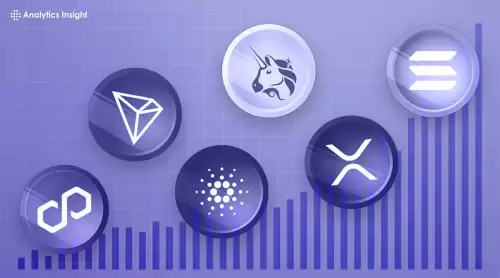 |
|
 |
|
 |
|
 |
|
 |
|
 |
|
 |
|
 |
|
 |
|
 |
|
 |
|
 |
|
 |
|
 |
|
 |
|
Cryptocurrency News Articles
Tether's Gold Rush: $8 Billion in Swiss Vaults and the Future of Stablecoins
Jul 09, 2025 at 02:00 am
Tether's foray into gold storage in Swiss vaults signals a strategic shift, blending crypto with traditional assets. What does this mean for stablecoins and regulation?

Tether's Gold Rush: $8 Billion in Swiss Vaults and the Future of Stablecoins
Tether's making moves, folks! They've stashed away nearly $8 billion in gold in a secret Swiss vault, blending the wild world of crypto with the old-school allure of precious metals. It's a bold strategy, but what does it all mean?
The Golden Hoard: Tether's Swiss Vault Strategy
Tether, now chilling in El Salvador, isn't just about stablecoins anymore. They're playing the gold game, big time. Their own private vault in Switzerland holds around 80 metric tons of gold. CEO Paolo Ardoino says it's all about cutting costs and being more independent. Makes sense, right? Why pay someone else when you can do it yourself?
With $159 billion USDT floating around, about 5% of Tether's reserves are now glinting gold. Unlike other institutions that use third-party custodians, Tether's going rogue (in a good way) and managing its own storage. This saves them some serious dough and puts them in the same league as major banks like UBS.
MiCA and the Regulatory Maze
But hold your horses! New rules in the U.S. and EU might throw a wrench in Tether's golden plans. These regulations could force stablecoin issuers to stick to cash and short-term government bonds. If Tether wants to play ball with regulators, they might have to ditch their gold stash. Ouch!
To hedge their bets, Tether also has XAUT, a gold-backed token pegged to physical gold in Switzerland. It's small compared to mainstream gold ETFs, but it's part of their long-term game. If XAUT takes off, that vault ownership could save them millions in fees each year.
Gold as a Hedge: Ardoino's Vision
Ardoino sees gold as a shield against unstable fiat currencies, pointing to the growing demand from BRICS nations and the U.S.'s mounting debt. "Gold is logically safer than any national currency," he says. But loading up on assets like gold might bring even more regulatory heat. Tether's walking a tightrope here.
Missing from the MiCA Party: Binance and Tether
Speaking of regulations, the EU's MiCA legislation has approved licenses for a bunch of crypto firms, but Binance and Tether are noticeably absent. Why? Well, Tether's facing scrutiny for audit transparency and reluctance to meet MiCA's strict standards. As a result, USDT has been booted from several EU exchanges. Tether's playing it cool, focusing on other markets until the EU chills out.
The Future: Hard Assets and Independence
By owning physical infrastructure and hedging with hard assets, Tether's gearing up for a future that might be less reliant on traditional finance. They're becoming harder to pin down, which could be a good or bad thing, depending on who you ask.
Final Thoughts: Is Tether Playing 4D Chess?
So, what's the takeaway? Tether's gold strategy is a bold move that could pay off big time. But with regulations looming and scrutiny intensifying, they're walking a fine line. Whether they're geniuses or just plain lucky remains to be seen. One thing's for sure: it's never a dull day in the world of crypto!
Disclaimer:info@kdj.com
The information provided is not trading advice. kdj.com does not assume any responsibility for any investments made based on the information provided in this article. Cryptocurrencies are highly volatile and it is highly recommended that you invest with caution after thorough research!
If you believe that the content used on this website infringes your copyright, please contact us immediately (info@kdj.com) and we will delete it promptly.




























































